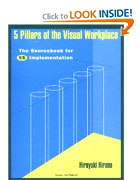Activity-Based Costing (ABC)
Activity-based Costing (ABC)
is a dynamic and systematic accounting methodology for realistically
calculating the actual cost of doing business, regardless of
organizational structure. ABC originated from the efforts of Dr. Robert
Kaplan of Harvard, who also conceptualized the
Balanced Scorecard.
Activity-based costing
involves the creation of models of the actual costs incurred by a company
at each stage of its core processes. In fact, a
cost
is
attached
to
every activity,
such that the cost of executing each activity may built into the cost of
producing the products or services offered by the company. As a
result, the cost contribution of each activity to the total cost incurred
by the company to manufacture its goods or render its services is
determined, and a better understanding of the company's cost structures is
achieved. The drawback of implementing ABC is that it requires time
and resources to implement it properly.
Proponents of
ABC believe that the major thrusts of a company such as continuous process
improvement and simplification to boost productivity can only be attained
if the
real
cost and time
required to produce its goods and services is determined. This will
prevent indiscriminate cost-cutting measures (such as miscalculated
downsizing) that may actually result in worse performance and
profitability.
An
activity
is defined as a process, function, task, or step that occurs over time and
generates results that the company uses to produce and sell its products
and services. An activity consumes resources as it transforms its inputs
into outputs, and therefore incurs a 'cost' every time it occurs.
Allowing an organization, or even every employee involved, to understand
the cost of doing each activity gives it a better chance to perform the
activity better while minimizing costs. In fact, the cost attached
to an activity may be used as a metric for organizational or personnel
performance.
ABC entails the
complex task of identifying discrete activities and identifying the
measure of output for each of these activities. Each activity also needs
to be classified as either 'value-added' or 'non-value-added.'
Value-added
activities are
activities that add value to the product or service that the customer is
willing to pay for. Thus, all steps required to manufacture a
product or enhance its quality or reliability are value-added activities.
On the other hand,
non-value-added
activities are activities that do not contribute any value to the final
product, and are other activities that the customer doesn't really want to
pay for. Staging of products and unnecessary inspection are examples
of non-value-added activities. Non-value added activities, in general,
must be eliminated if possible.
Activity-based
costing consists of the following
steps:
1) analysis of activities; 2) cost data gathering; 3) tracing of costs to
activities; 4) establishment of output metrics; and 5) cost analysis.
The
analysis of
activities
of a company
starts with identifying which activities will be covered by the analysis.
Experts recommend the analysis of at least half a dozen organizational
units with a common functional orientation to start the program. The
analysis of each activity includes, among other things, determining the
following: 1) whether it is value-adding or non-value-adding; 2) whether
it is primary or secondary; and 3) whether it is absolutely required or
not (discretionary).
As discussed earlier,
value-adding
activities contribute something of 'value' directly to the manufacture of
the products or rendering of the services sold to the customer, while
non-value-adding
activities do not.
Primary
activities
directly support the company's mission while
secondary
activities
simply support the primary activities.
Required
activities need to be performed all the time, while
discretionary
activities are those that are only performed if allowed by management.
Cost data
gathering
involves the determination of the costs incurred by the activities being
analyzed. These costs include salaries of the people performing the
activities, material costs, equipment and furniture costs, and even R&D
costs. Actual cost data are preferred but if they're unavailable,
estimates based on cost formulas may be used.
The
tracing of
costs to activities
refers to the process of determining where the total cost of each output
comes from. Every output of an organization was produced by one or more
activities, each of which incurred costs when undertaken. This step aims
to determine where the costs are being incurred in producing an output, by
determining which activities are needed to produce that output and what
costs are incurred in each of these activities.
The
establishment of output metrics
pertains to determining the total cost of producing an output. It consists
of the calculation of the actual activity unit cost for each primary
activity and the generation of the bill of activities. The activity
unit cost of an activity is the total input cost divided by the primary
activity output volume. The total input cost should include both the
costs incurred by the primary activity and its associated secondary
activities. The bill of activities is the list of activities (and
their corresponding consumed amounts) needed to produce
the output.
The total cost of the bill of activities is the sum of each activity unit
cost multiplied by its corresponding activity amount consumed.
The
analysis of
costs is
the step wherein the activity unit costs and bills of activities are
analyzed to identify areas for further improvement in the companies'
business processes. This is where non-value added activities are
properly identified for elimination, resulting in better business
performance and greater efficiency.
See Also:
Knowledge Management;
Balanced Scorecard
|
Books recommended for you: |
|
 |
 |
 |
 |
HOME
Copyright
©
2005
EESemi.com.
All Rights Reserved.

